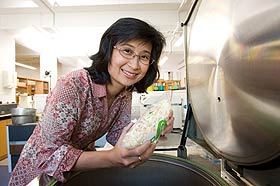

Professor Indrawati Oey
“We can extend the shelf life of the product by inactivating micro-organisms and undesirable enzymes while we keep the initial taste, flavour, colour and nutrient content.”
A means of food processing and preservation that maintains nutritional benefits, taste, colour and appearance while at the same time keeps the product stable, safe and easy to use is something of a holy grail for food scientists.
Professor Indrawati Oey (Department of Food Science) is exploring various novel processing technologies to obtain healthy and safe food products.
One of the techniques she is championing is the use of high hydrostatic pressure (HP) processing as a way of killing bacteria and extending shelf life with maintaining the initial quality. Pre-packed food products are simply put under hydrostatic pressure above 1,000 bar, or 1,000-times the atmospheric pressure.
“The beauty of this technique is that we can extend the shelf life of the product by inactivating micro-organisms and undesirable enzymes while we keep the initial taste, flavour, colour and nutrient content,” she explains.
“Another feature of HP is that, as well as preserving the food, high pressure can make important changes to its quality, functionality and usability by activating and inactivating different naturally-occurring enzymes and chemical processes in the food. Therefore, this technique also has potential to obtain natural functional food products – for example, food products with higher nutrient bio-accessibility and bio-availability.”
Another novel technique being explored is high electric field pulse processing – a technique that has the benefit of being able to enhance the extraction of membrane-bound bioactive compounds and flavour.
While processing is important, Oey says the initial quality of raw materials and prepared foods before processing also plays a major role in determining the final quality of processed food products, so she is also re-evaluating different steps of conventional food handling after harvest and different strategies of conventional food preparation before processing.
Oey was previously based in Belgium and involved in European projects to develop these techniques. HP has become more intensively studied for industrial application in food processing and preservation in Europe, Japan and America, and interest in the technique is also significantly growing in Australia and New Zealand.
She is keen to develop industry partnerships here and collaborate with other University departments, as well as Crown Research Institutes such as the Riddet Institute and Plant and Food Research.
“My role is as an industrial advisor – helping them have sustainable food processing and more profit by producing safe and better quality food products by adopting new processing strategy and technology.” Pressure on food processing
Funding
- Research Foundation-Flanders (Belgium)
- EU funded Integrated Project - NovelQ
- EU funded STReP (Specific Targeted Research Projects)
- Project – Healthy Structuring
